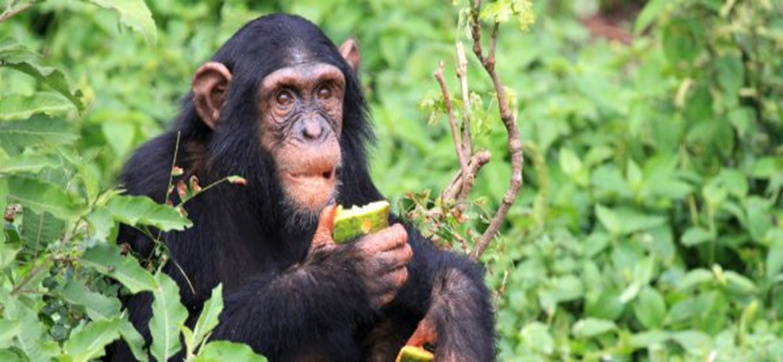Chimpanzees are able to learn different local dialects

The monkeys' vocal cue changed, but their love of apples did not
A study conducted by researchers in Edinburgh on two groups of chimpanzees says that chimpanzees can communicate better with newcomers to their group.
The study began in 2010 when nine chimpanzees were brought in from a Dutch safari park to live with a group of monkeys that had grown up in Edinburgh.
The group from the Dutch Park used high vocal signals indicating interest when asking for apples, while the local group used a low tone of voice that involved less interest in the food of the same type.
By 2013, the audio signals used by the ability coming from the Netherlands had changed, so that the group members used quieter audio signals, despite their fondness for the apple fruit, which had not diminished over those years.
The results of the study, published in the Journal of Current Biology, suggest that the vocal signals used by chimpanzees to point to objects can play the same role as the words that humans utter during communication, rather than being limited to being a way for this animal to express what it feels.

Our ability to learn words from those around us appears to be due to a method chimpanzees used to learn vocal signals six million years ago.
“An effective way to try to understand how language evolved is to look at the communication systems of animals closest to humans,” says Katie Slocombe, senior author of the exciting working paper on chimpanzee vocalizations and professor of physiology at the University of York.
She added that it is necessary to search for an answer to a set of questions, including: "What are the basic skills of communication in which man shared with his ancestors of beings? And what are the skills that are unique to man and not others, and that have developed since the beginning of creation?"
better nor better
While working on the study, the research team discovered that several sound signals emitted by this species of monkey may refer to certain types of food such as apples and bread.
Some monkeys may respond by looking at similar types of food when they hear these calls or vocal signals.
But many studies considered these vocal signals as mere "semantic calls" that express the emotional value of the types of food in monkeys.

The change in vocal signals came after years of social interaction
Therefore, the current study resorted to bringing a number of monkeys of the same species from the Peaks Bergen Safari Zoo in the Netherlands to Edinburgh to prove its theory.
The work revealed that the 'word', which here refers to the phonetic signal used by monkeys, in referring to apples in a group of monkeys in Edinburgh sounds soft and reflects a normal desire to eat apples as the desire to eat any other food.
In contrast, the incoming group of monkeys used loud vocal cues that reflected intense interest and desire for apples.
Until 2011, researchers had not made much progress on finding that chimpanzees from the Netherlands could learn the vocal cues of their peers in Edinburgh.
Each group of monkeys used the old calls they used to ask for certain types of food.
However, given the change in the social behavior of the expatriate group, it was proven that they are not making significant progress.
Emotional value constancy
"Both groups of monkeys didn't spend a lot of time together, and they didn't make many friends," said Katie Slocombe.

"It was clear that the incoming monkeys had no motivation to change their calls," she added.
But by 2013, the monkeys from both groups had begun to form friends, and one larger group emerged, containing 18 Scots and Dutch monkeys.
In conjunction with this social bonding that took place between the two groups, a great deal of change appeared in only one aspect of the communication between the group members.
"The monkeys from the Netherlands are starting to use the same food calls as the monkeys from Scotland when they want to eat an apple," Katie says.
However, the level of love for apples did not decrease in either group, as the Scots still showed a normal or neutral desire to eat apples, while the Dutch fondness for apples increased.
According to the authors of the study, this is the first evidence that verbal communication and sounds may have been used between creatures other than humans millions of years ago.
Source: websites

